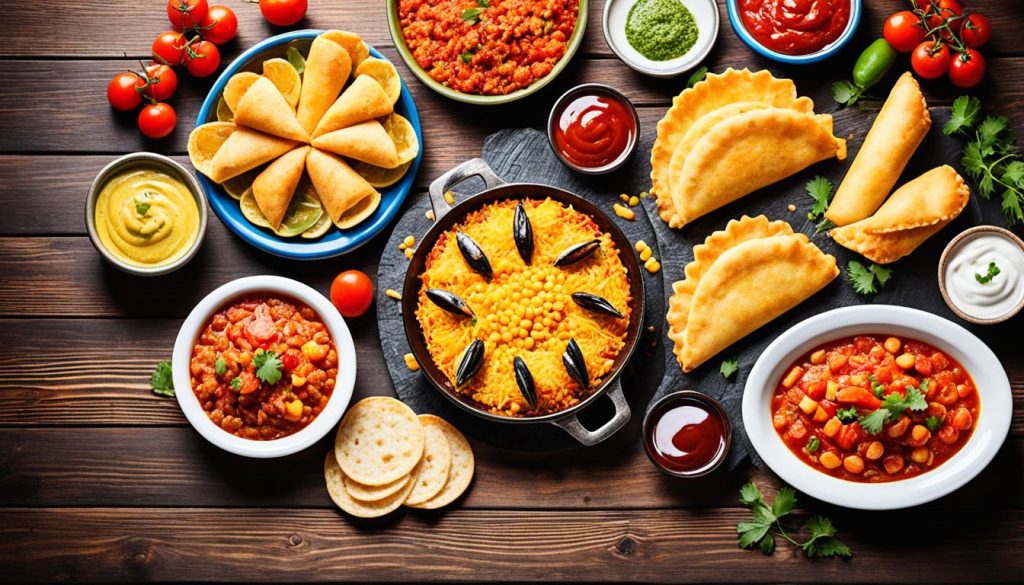Familiarizing oneself with the translation of food in Spanish is not just about memorizing vocabulary; it’s about venturing into a universe where culture, tradition, and history converge on the plate. Embracing the Spanish language means unlocking a culinary ecosystem brimming with flavors and expressions. As you embark on this linguistic journey, you’ll find that the way to say food in Spanish surpasses mere words—it captures the essence of feast and fellowship. So let’s set the table for a delightful exploration of food vocabulary in Spanish, a tantalizing topic for travelers, gourmands, and language enthusiasts alike.
Key Takeaways
- Effortless mastery of how to say food in Spanish through real-world applications.
- Insights into the perfect translation of food in Spanish for every dining scenario.
- Comprehensive approach to grasping the expansive food vocabulary in Spanish.
- Cultural appreciation through the understanding of food-related terms.
- Enhanced communication with native speakers about Spanish dishes and ingredients.
Understanding the Basics: “Comida” and Other Terms for Food in Spanish
Grasping the fundamental vocabulary related to comida in Spanish is essential for anyone looking to appreciate the rich culinary traditions of Spanish-speaking cultures. “Comida” not only embodies the concept of nourishment but also encompasses the societal and emotional significance of sharing a meal. Let’s delve deeper into the subtleties of translation of meal in Spanish and other synonyms that enrich the language.
The Most Common Translation: Comida as a Meal
In its most universal application, “comida” refers to any general meal and is the umbrella term under which various eating occasions reside. The word intersects with daily life and conversational Spanish, making it a key term for anyone learning the language. When discussing plans for eating, whether breakfast, lunch, or dinner, comida naturally finds its way into dialogue.
Exploring Synonyms: “Alimento” and “Comestibles”
The richness of Spanish vocabulary allows for several synonyms for food in Spanish. “Alimento” is often used in contexts emphasizing the nutritional value or sustenance provided by food, as in discussions about health, diet, or the food industry. “Comestibles,” however, tends to take a broader scope, referring to edible items available for consumption, particularly in grocery stores or markets.
Variations in Context: When to Use Different Words for Food
- Comida: Utilized when referring to meals or dining experiences.
- Alimento: Used when the focus is on the nourishment or health aspects of food.
- Comestibles: Most appropriate when talking about edible products or groceries.
Understanding the variations of food in Spanish can significantly improve communication with native speakers and enhance one’s comprehension of the cultural importance of food in Spanish-speaking societies. Below is a table illustrating the different contexts in which each term is typically used.
| Term | Typical Usage | Context Example |
|---|---|---|
| Comida | Generic meal reference | Inviting someone for a meal: “¿Te gustaría compartir la comida conmigo?” |
| Alimento | Nutritional emphasis | Discussing dietary needs: “Es importante incluir suficientes alimentos ricos en proteínas.” |
| Comestibles | Edible goods for purchase | Shopping for groceries: “Voy al mercado a comprar comestibles para la semana.” |
How to Say Food in Spanish: Pronunciation and Usage
Grasping the pronunciation of food in Spanish is integral to engaging in clear and meaningful conversations, particularly when it comes to dining experiences. As you familiarize yourself with the usage of food vocabulary in Spanish, practice is paramount. We will guide you through the subtleties of speaking about food in Spanish, from navigating menus to expressing dietary preferences, ensuring you embody confidence in every exchange.
The following table provides an overview of some essential food items, with their Spanish translation and a guide to their pronunciation. Mastery of these basics will empower you to order meals, inquire about ingredients, or discuss your favorite dishes with poise and precision.
| English | Spanish | Pronunciation (IPA) |
|---|---|---|
| Bread | Pan | /pan/ |
| Cheese | Queso | /ˈkeso/ |
| Fruit | Fruta | /ˈfɾuta/ |
| Vegetables | Verduras | /beɾˈðuɾas/ |
| Chicken | Pollo | /ˈpoʎo/ |
| Fish | Pescado | /pesˈkaðo/ |
| Water | Agua | /ˈaɣwa/ |
| Wine | Vino | /ˈbino/ |
Context is crucial when selecting the appropriate food-related terms. While in a restaurant, mentioning “Quisiera pedir…” followed by the name of a dish indicates your intention to order. Expressing culinary preferences could start with “Prefiero…” or “Me gusta…”, allowing for a personal touch. Whether it’s “Sin sal, por favor” for health reasons, or “Más picante, por favor” to indulge in a love for spices, the proper usage of food vocabulary in Spanish bridges the gap between mere translation and genuine connection.
To aid in your practice, listen to native speakers and repeat phrases to hone your pronunciation. Engage in dialogues or utilize language learning apps that emphasize speaking and listening skills—real-time feedback is invaluable for advancement.

- Always try to mimic the tone and rhythm of native speakers to improve your pronunciation.
- Regularly use new vocabulary items in conversations to reinforce memory and fluency.
- When possible, visit Spanish-speaking areas to immerse yourself in the language and culture.
Ultimately, the journey to mastering the pronunciation of food in Spanish is one that is as delightful as the cuisine itself. With continual practice and exposure, you’ll soon find yourself speaking about food in Spanish with the same zest with which it is enjoyed!
Expanding Your Vocabulary: Food Categories and Types in Spanish
As you venture further into the rich language of Spanish cuisine, a clear understanding of food categories in Spanish becomes indispensable for any connoisseur or language enthusiast. Familiarize yourself with frutas (fruits) and verduras (vegetables), as these are fundamental components of a balanced diet and are commonly found in markets and menus across Spanish-speaking countries. Whether it’s a crunchy manzana (apple) or a ripe tomate (tomato), being able to identify these items can enhance your shopping experience and dietary conversations.
Discussing types of food in Spanish extends beyond produce to encompass a diverse array of staples such as granos (grains), productos lácteos (dairy products), and carnes y pescados (meat and fish). Mastering terms like arroz (rice), leche (milk), pollo (chicken), and salmón (salmon) will enable you to navigate a plethora of dining situations, from grocery shopping to ordering an exquisite meal in a Spanish restaurant.
Expanding food vocabulary in Spanish is not merely about memorizing lists of words; it’s about engaging with a culture through its culinary delights. Enhance your understanding by learning about legumbres y frutos secos (beans and nuts), which add a healthful variety and richness to numerous traditional dishes. The more you practice and familiarize yourself with these foods and their corresponding Spanish names, the more prepared you will be to indulge in the vibrant world of Spanish gastronomy. Armed with this knowledge, you’re ready to embark on a flavorful journey through the diverse landscape of Spanish-speaking cuisines.


